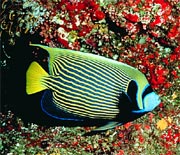|
Great Barrier Reef
The Great Barrier Reef we see today is about 12,000 years old, and for most of that time there has been minimal human presence. Around 1850, European settlers began populating and developing the Queensland coastal strip, along the inner boundary of the Great Barrier Reef.
During that time, human settlement has impacted the Great Barrier Reef. Nowadays, the water isn't as clean, the coral isn't as healthy, there are fewer fish and some animals and birds aren't as common as they once were. |
 |